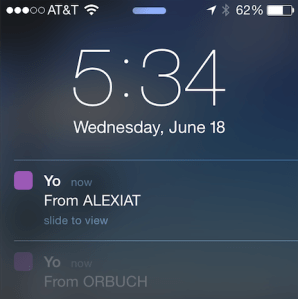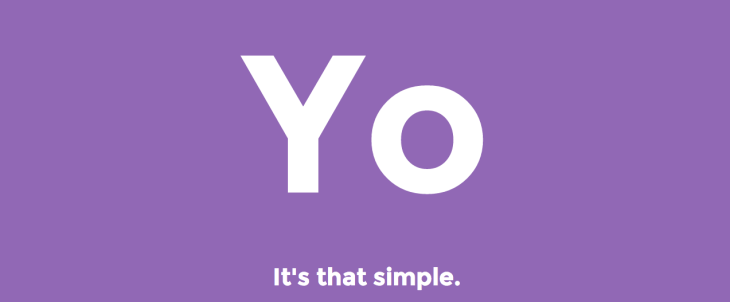Yo.
It seems so simple. So mindless. It’s only slightly less boring than “Hey” or “Hi,” if only because of some perceived aggression or excitement attached to it. But Yo is anything but simple.
If you haven’t been following along on Twitter, Yo is the hottest new app that will leave you scratching your head. The entire premise of the app is to send other users a single word: Yo.
Yo currently has over 50,000 active users, after launching as a joke on April Fools’ Day. Users have sent over 4 million Yo’s to each other. Without ever having officially launched, co-founder and CEO Or Arbel managed to secure $1.2 million in funding from a list of unnamed investors, except for co-founder, angel, and Mobli CEO Moshe Hogeg, who participated in the round.
It might have started out as a joke, but the app has turned into something more universally enjoyable, and its brief popularity tells us something bigger about where the mobile social landscape is headed. We’re seeing the death of digital dualism play out before us, with apps focused on merging the physical and digital worlds. Snapchat has ephemerality. Whisper and Secret have anonymity.
And Yo has context.
Context > Content
Let’s back up for a second.
You’re at a bar with your best friend and a love interest. Both put a hand on your shoulder when they talk to you. From the outside, it all looks the same. But there’s a big difference between the comfortable touch of a close friend and the explorative graze of someone you may very well have sex with soon.
The next morning, your friend and your crush send you the exact same text. It says simply “Hey.” From your old pal, “hey” just means hey. But from your sexy friend, “hey” can mean anything from “last night was fun” to “I’m still thinking about you this morning.”
As with anything, a “Yo” can just be a yo. But you’ll feel a very real difference between a “Yo” you get in the morning from a friend and a “Yo” you get at 2 a.m. from a friend with benefits. Trust me.
And that’s… supposedly… the magic.
The context of the Yo says much more than two little letters. And this is more important than it sounds.
Digital Dualism FTW
There’s a common thread surfacing around the most popular social apps of today, and that similarity is an understanding of digital dualism.
The entire purpose of Snapchat is to bring the interactions on your smartphone as close to real life as possible. The photos disappear because moments in real life disappear. The window showing your own face during a video chat disappears, because when you’re talking to someone in real life, you aren’t normally looking at your face as well.
Secret and Whisper are two other examples. People love them because the thoughts and emotions and jokes being shared on them are coming from a real place. These Secrets and Whispers are the feelings we have on the inside, not the beautified life we share on social media sites like Instagram and Facebook.
Yo’s digital dualism play is far more understated, but perhaps more universal. Again, it comes back to context.
In real life, a grin can mean the difference between a playful joke and a hurtful sarcastic comment. A call from your boss at 11 a.m. and a call from you boss at 11 p.m. can mean the difference between a simple question and a full-fledged professional emergency. A farewell hug at a crowded party has a very different weight to it than a farewell hug after a quiet night of TV and wine.
These context clues are what makes life fun, and they’re what makes Yo more interesting than the joke it started out as.
Timing Is Everything
You may recall that Facebook launched an app yesterday called Slingshot. Despite its shitty UI and the fact that Facebook itself is about as attractive to young people as oversized Christmas sweaters, Slingshot does have one relatively exciting feature: Reciprocation. In order to see an inbound photo or video message in Slingshot, you must first respond to that message with your own photo.
Forced friendship.
In theory, it’s a smart idea, especially considering that Facebook actually causes depression among its users. But Slingshot is going up against an established user base on Snapchat, and essentially forces people to take pictures to enjoy the app.
This is a big no-no. Consumers are a huge part of any social network’s user base. Not everyone has something to share, and not everyone feels comfortable sharing, but almost everyone can enjoy voyeurism on the Internet. The consumers depend on the creators and vice versa. Asking everyone to become creators — especially on a level as intimate as photos and videos — is like asking a sea full of various fish and coral to all become sharks.
Yo pretty much tricks users into this reciprocation. When you receive a Yo, it appears in your Yo inbox as the sender’s name. When you tap on that name (presumably to open the message and see the “yo” contents), you just send a Yo back.
In that way, Yo is much more representative of a Yo-yo. (You can actually send a Yo-yo on Yo by tapping a name twice.) The Yo’s go back and forth. They quickly become spammy. And still, it doesn’t really matter. With Yo, the frequency doesn’t make a difference and the content is irrelevant. There’s no infringement of personal space when I’m sent a Yo, and sending one back asks for nothing from me (the way a photo does). The app isn’t anonymous, but sending off a Yo feels even more lightweight than shooting off a Secret or a Whisper. It’s small. It’s the same for everyone. It’s nothing.
It’s yo.
/yō/
Yo is actually a very interesting word. It seems that no one really agrees on its meaning or its origin.
Some say it comes from the 14th century, and others argue that it originated much earlier than that, across various continents like Asia and Africa before hitting Europe. Some say the word’s lineage began on the high seas, as a term that meant “present” or “accounted for” to sailors in the Navy, etc.
Its popularization is often traced back to the community of Italian-Americans and African-Americans living in close proximity in Philadelphia during the 40s, as both groups adopted the term as a way to say “Hey you!”
It’s a noise that is used in almost any language, and a sound that carries long distances.
In some cultures, the term “yo” or “io” refers to the first person. Me. In others, it has a closer correlation to the second person. You.
But in almost every case, “yo” is generally defined as a way of directing the attention of two individuals to each other. “Hey you! Look at me!” It’s human connection. Beyond all the context clues and the multiple meanings of the word itself, Yo is about the connection between two people.
“Yo already means different things to different people, and it can have a different meaning depending on who you say it to and how you say it,” says Arbel. “That ambiguity was exactly what we were looking for in an app that is all about context.”
Give Me Yo’ Money
An app like this, while cute and convincing and addictive, will inevitably fizzle out if used solely for friends communicating with one another. And Arbel is aware of this.
Right now, the app offers a free API that will let any organization get set up with a Yo account. The system is in place for the World Cup. If you send a Yo to WorldCup, you’ll get a Yo every time a goal is scored. Theoretically, TechCrunch could add a Yo button to the site for readers who want to know when the biggest breaking news hits the site. Our account would send a simple Yo, perhaps the most lightweight push notification of all time, straight to your phone so you’re in the loop.
It’s that simple.
 “It’s really lightweight,” said Arbel. “You don’t have anything to open. The Yo is everything, it’s all there is. You don’t have a badge you need to remove or any hidden content. Just a Yo.”
“It’s really lightweight,” said Arbel. “You don’t have anything to open. The Yo is everything, it’s all there is. You don’t have a badge you need to remove or any hidden content. Just a Yo.”
For now, the company is focused on acquiring more users, which includes getting as many developers on the API as possible. But the API could eventually turn into a source of revenue.
And that’s not all.
Arbel envisions a time when you’ll be able to buy Yo’s in celebrity voices to send to your friends or flings or foes. But beyond a shadow of a doubt, Arbel will never introduce the option to buy more words. Yo is all there is.
Arbel is the only person working full time on the app, which has a fresh $1.2 million in funding, but he’s looking to hire Android engineers in the Bay Area.
Yo or No?
I’m going to go ahead and place my bets early (as I’m wont to do), and say that Yo will have dropped out of our collective consciousness by next year. But that’s not to say we should write it off as a silly gimmick.
The brief popularity of Yo is a signal of a larger trend. Software developers are today tasked with a bigger problem than convenience or accessibility or distribution. The line between our physical lives and the lives we lead in our minds, with our thumbs, on a touchscreen, is rapidly fading. Yo may be just a touch too basic (bitch) to last for the long haul, or perhaps Yo is the beginning of a new era in push notifications. But apps that integrate pieces of our real-world lives are just settling in for a long stay.
